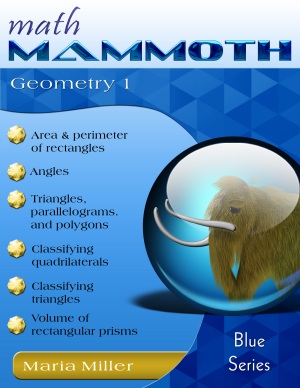Lines, Rays, and Angles
This fourth grade geometry lesson teaches the definitions for a line, ray, angle, acute angle, right angle, and obtuse angle. We also study how the size of the angle is ONLY determined by how much it has "opened" as compared to the whole circle. The lesson contains many varied exercises for students.
|
||||||||||
|
A line has no beginning point or end point. Imagine it continuing
indefinitely in both directions.
We can name a line using two points on it. This is line EF or line
|
||||||||||
|
||||||||||
|
That
point is called the vertex and the two rays are called the
sides
|
1. Write if each figure is a line, ray, line segment, or an angle, and name it.
|
a. _______________________ |
 b. _______________________ |
c. _______________________ |
 d. _______________________ |
 e. _______________________ |
 f. _______________________ |
 2.
a. Find the angle formed by the rays DE and DF.
2.
a. Find the angle formed by the rays DE and DF.
How do we name it?
b. Find the angle formed
by the rays CA and CE.
How do we name it?
c. What is BD? (a line, a
line segment, or a ray)?
3. a. Draw two points, D and E. Then draw line DE.
b. Draw point Q not on the line.
c. Draw rays DQ and EQ.
d. Find angles EDQ and DEQ in your drawing.
|
|||||
 If the angle opens up to a
full |
 This angle is half of the full circle, Your two pencils (rays) are
lying |
 This is one-fourth of the This is called the right |
|||
|
In each of these pictures the angle is opened more and more and keeps getting bigger. The arc of the circle is larger. These angles are acute angles, which means they are less than a right angle (less than 90°). Think of acute angles as sharp angles. If someone stabbed you with the vertex of an acute angle, it would feel sharp.
|
The angle is opened even Think of obtuse angles as |
||||
|
Here's another way of thinking about angles. Think of a sun rising in the morning in the horizon, gradually getting higher, and traveling through the sky along an arc of a circle. |
|
| How big is the angle? It does not matter how long the sides of the angle are. Remember, they are rays, and rays go on indefinitely. But when we draw them on paper, we have to draw them as ending somewhere. The sides of the angle might even seem to have different lengths. That doesn't matter either. The size of the angle is ONLY determined by how much it has “opened” as compared to the whole circle. Think how big an arc of a circle the sides have drawn, as compared to a whole circle. |
||||||||||||
|
4. Which angle is bigger?
|
|
|
||||||||||||
|
|
|
5. a. Sketch three different
acute
angles.
b. Sketch three different
obtuse angles.
c. Sketch a right angle
and
a straight angle.
6. Label the angles as acute, right, obtuse, or straight. To
help, make these angles with two pencils,
checking how much you need
to open up the angle.
|
|
|
||||||
|
|
|
||||||
|
|
|
7. A triangle has three angles. In fact, the word tri-angle means a three-angled shape.
| Which of the triangles a, b, or c has one obtuse angle? |
a. |  |
b. |
 |
c. |  |
8. (Optional) Make a
geometry notebook where you write down each new term and draw a picture
or
pictures that illustrate the
term. Use colors and tidy writing. It is like your
personal geometry
dictionary. You can also do any drawing problems from the
lessons in it. Drawing and writing
yourself, instead of
just reading, can help you remember the terms better!
| New Terms | ||
|
This lesson is taken from Maria Miller's book Math Mammoth Geometry 1, and posted at www.HomeschoolMath.net with permission from the author. Copyright © Maria Miller.
Math Mammoth Geometry 1
A self-teaching worktext for 4th-5th grade that covers angles, triangles, quadrilaterals, cirlce, symmetry, perimeter, area, and volume. Lots of drawing exercises!
Download ($6.90). Also available as a printed copy.






 What is
an angle? Many people
think that an angle is some kind of
What is
an angle? Many people
think that an angle is some kind of To name an
angle, we use three points, listing the vertex in the middle.
To name an
angle, we use three points, listing the vertex in the middle.





















